| Reviews & Columns |
|
Reviews DVD TV on DVD Blu-ray 4K UHD International DVDs In Theaters Reviews by Studio Video Games Features Collector Series DVDs Easter Egg Database Interviews DVD Talk Radio Feature Articles Columns Anime Talk DVD Savant Horror DVDs The M.O.D. Squad Art House HD Talk Silent DVD
|
DVD Talk Forum |
|
|
| Resources |
|
DVD Price Search Customer Service #'s RCE Info Links |
|
Columns
|
|
|
Freedom (Limited Edition Collection)
Bandai Visual USA // Unrated // November 11, 2008
List Price: $139.98 [Buy now and save at Amazon]
Bandai Visual's
OVA Freedom landed a footnote or two in the format war, with the series' sixth volume having the distinction of being the last HD DVD ever released on these shores. An enormous amount of work went into creating those HD DVDs -- they were the first 'twin format' discs released on the format, Bandai Visual worked closely with Microsoft in optimizing their encoding tools for this cel-shaded anime series, and its exceptionally interactive picture-in-picture feature was one of the best tech demos that HD DVD served up in its two years of life. Bandai Visual could've just recycled the effort they invested into their HD DVDs, but they opted to start from scratch when they brought Freedom to Blu-ray, offering a new set of video encodes, multiple lossless audio options, and a slew of new extras...and at a fraction of the sticker price to boot.
Following a series of catastrophic wars that left the planet a smoldering, uninhabitable cinder, the survivors of Earth carved out of a new society in a series of colossal domes on the moon. On the surface, Eden may appear to be as idyllic as its name suggests, but this futuristic metropolis is governed by the heavy hand of the Citizens Administration Council. This oppressively totalitarian group refers to its people by a series of cold, detached letters and numbers, shoves them into lifelong careers that may or may not be of the least bit of interest to them, and covertly restricts their movements and the flow of information.
The council first clashes with a fifteen year old named Takeru as he distracts himself from his impending regimentation into the status quo by racing a Lunar Terrain Vehicle. Takeru's LTV has been dramatically souped-up with the help of his friends Bis and Kazuma, and after his illegally raced lunar rover bursts into flames and causes him to miss curfew, his punishment is to skulk around outside the dome and verify the integrity of the arteries of pipes and cables leading into Eden. While unsupervised outside the dome, a hopelessly frustrated Takeru spots something careening to the lunar surface and bounds over to take a look. Inside the crater, he stumbles upon a photo of a beautiful teenage girl standing in front of a lush field of grass and some sort of launchpad, and a message reading "We are safe. Is anybody out there?" is scrawled on the back.
Instantly smitten,
Takeru becomes hellbent on tracking down his dream girl. He and his friends scour as much of the colony as they can, but they fail to turn up any trace of her, and the city's sprawling computer network is unable to match the background of the photo to anything in its extensive database. On a lark, Takeru decides to cross-reference it with the last recorded images of Earth. This at first just turns up the same images he'd seen all his life of the scorched, barren planet, but his persistence unexpectedly locks down the entire network. Alan -- a mysterious old man with his own closely guarded secrets -- offers to lend a hand, but his unexpected familiarity with the hidden innards of Eden inadvertently places Takeru in grave danger as the colony's protectors set out to prevent an elaborate conspiracy from starting to unravel.
The first arc of Freedom is geared around a dark Orwellian future, and that dystopian sense of uneasiness and distrust is infused with energy through a series of hyperkinetic underground races and chases from armies of monstrous cybernetic spiders. The series takes a jarring shift in setting and tone as it settles into its fourth volume, though. Takeru and Bis spend half the episode piling onto a psychedelic VW bus with a man-ape, a Jimi Hendrix knock-off, and some schlub in a beer hat, with their road trip followed on a kitschy map with the names of cities and Route 66 logos bouncing around to some country-fried electric guitar lick. There's much more of an oddball sense of humor this time around, including an kinda-sorta-not-really-intergalactic dance party and a bit with Takeru practicing his romantic chops by having Bis squeak away in the role of a nameless girl in a photograph. It's literally a world removed from where the series began.
I'll admit to really disliking this stretch of the series when I first watched Freedom on HD DVD, and I think it's really just because it's essentially an entire different show. I'm sure that's the point, even: to contrast the distrust and cold technological bent of the lunar colony of Eden to a society that's archaic but practically utopian by comparison. It just seems awfully anticlimactic to open a series with swarms of teenaged racers
careening around underground tubes, outnumbered and outgunned by an army of oversized robots...to have dozens of heavily armed soldiers converging on a dusty space shuttle aimed towards a planet the government had long claimed was a smoldering wasteland...only to spend the next two volumes tooling around on tractors, scarfing down squid, making goo-goo eyes at Earth gals, and palling around with a goofball in an ape getup. Still, watching Freedom again on Blu-ray and knowing in advance what I was getting into, I found myself appreciating these episodes quite a bit more. The story couldn't function without the stark contrast between these two central arcs, and maintaining the same breakneck pace and ominous tone would stifle this impulsive, hormonal, aimless teenager from growing up the way he does.
Even for those disappointed by the direction the series' second arc takes, Freedom is back at full strength by the time volume six rolls around, nimbly weaving together the present, faded memories of the past, and a future still to come. The characters' personalities are drawn more sharply, Freedom's themes and underlying message come much more into focus, and it starts to toy again with the concept of what freedom represents and the layers of mystery swirling around this dystopian future. I didn't have a chance to watch the series' double-length finale until this boxed set arrived, and I was thrilled to see Freedom come to such an outstandingly strong conclusion. The seventh and final volume brings these two very different arcs together, all of the lingering questions are at long last answered, and there's a sense of scope and enormity that eclipses anything Freedom has offered up to this point.
I definitely enjoyed Freedom. Its earlier volumes held up really well even the third and fourth times through, and I found myself having a much greater appreciation for its second arc when I rediscovered the series on Blu-ray. It doesn't quite ring true that the story hinges on a fifteen year old going to these mindbogglingly absurd lengths purely because he has a crush on a girl in a picture -- something that's smirked at late in the series -- but Freedom is anchored around an effective blend of shadowy intrigue, hyperkinetic action, and breezy fun. Freedom won't redefine the way you look at anime or anything, no -- although it may leave you aching for some Nissin Cup Noodles that get an awkward closeup or two every volume -- but this OVA is worth seeking out on Blu-ray. Recommended.
Video: Bandai Visual has given Freedom a new set of AVC encodes for this Blu-ray release, and the series looks incredible. The linework in the cel-shaded CG animation is exceptionally sharp and crisp, worlds removed from the limited resolution of a standard definition DVD. The 1.78:1 image is frequently bright and colorful -- it opens in a metropolis named Eden, after all -- and the occasionally painted backdrops add a layer of texture and personality that meshes
surprisingly well with the CG imagery. This is some of the most convincing cel-shaded animation I've seen, and if not for some slight stiffness and jerkiness, it wouldn't be all that tough to believe that these characters had been drawn by hand. Black levels are deep and robust as well.
I'm really not left with much to complain about at all. There is some light aliasing along with a bit of banding, although both struck me as less distracting on Blu-ray than in the DVDs and HD DVDs I've watched of Freedom. I spotted one nasty instance of shimmering during a vertical pan early on, but nothing like that ever reared its head again. Even nearly a year and a half after I first caught Freedom on HD DVD, I'm still impressed by how wonderful the series looks in high definition, and it's appreciated that Bandai Visual went to the extra effort of re-encoding these seven volumes with Blu-ray expressly in mind.
Audio: Each volume of Freedom features its original Japanese audio in 24-bit Dolby TrueHD, and these lossless soundtracks are outstanding. There's a noticeable distinctness and clarity to every element in the mix, and the voice acting is especially clean and clear, never overwhelmed even in Freedom's most chaotic moments. The low-end is colossal: the roar of the souped-up LTVs, booming rocket thrusters, a violent hurricane, a few titanic explosions, and a remarkably punchy soundtrack. The series is littered with silky smooth pans from one channel to the next as the LTVs scream across the screen and swarms of spiderlike robots skitter in chase, swiping with enormous metal claws. Freedom takes full advantage of the six channels it has at its fingertips, and it's very welcome and completely unexpected for the series to be presented at such a high bit-depth, trumping much of what considerably larger studios have been releasing day-in and day-out.
Freedom also includes English and French dubs in Dolby TrueHD, although these lossless soundtracks are 16-bit, lagging behind the 24-bit Japanese audio. Subtitles are optionally offered in English and French as well. Each disc opens with a language selection screen -- Japanese, English, or French -- which defines the text for the submenus along with the default soundtrack. Pausing the episode and fiddling through a few submenus is a bit of a headache for those of us who don't speak Japanese but still want to watch Freedom in its original language.
Extras: There is one
notable loss from the individual HD DVD volumes of Freedom -- the sets of rough sketches and early renders that played in a heavily customizable picture-in-picture window with each episode -- and although that's a disappointment, Bandai Visual makes up for it well enough on Blu-ray with a slew of new extras.
"Talking About Freedom" is divided into two sessions with director Shuhei Morita and writers Dai Sato and Gichi Ohtsuka, focusing primarily on the first four installments of the series. Unfortunately, there's not really a followup delving into the other three volumes. The first session (17 min.) discusses the intermingling of an OVA with what amounts to a feature-length commercial and discusses the significance of what the Apollo program represents. For the most part, though, the emphasis is squarely on the writing process: how the series came together, the collaborative approach behind the assembly of the first arc, the integral roles that Katsuhiko Chiba (Outlaw Star; Gundam Wing) and Yuuichi Nomura (Gundam Seed) played, and the personalities and growth of Freedom's central characters.
The other session (21 min.) reflects on the first arc, touching on the expressiveness of these CG characters, the momentum that snowballed as the project went along, and Freedom's tendency to emphasize visuals and sound effects over dialogue. The three of them devote a fair amount of time to discussing the fourth episode of the series, including concerns about taking Freedom in such a dramatically different direction and laughing about their favorite scenes.
Sato and Morita are featured again in "Freedom in the USA". The first installment (11 min.) follows the two of them as they promote their OVA at Anime Expo '07 and as they briefly visit Route 66, a highway that plays a fairly prominent role in one volume of the series. In the second half (13 min.), Sato and Morita explore the National Air and Space Museum, researching the backdrop for one of Freedom's later volumes. Their awe and enthusiasm is infectious, marveling at sketched schematics, space suits, rockets, and lunar modules, and they're constantly relating these exhibits to Freedom's characters and storylines.
The Apollo program is also the focus of two other featurettes. "Fly Me to the Moon: The Apollo's Journey" (10 min.) uses an enormous amount of vintage footage and narration to cover the evolution of technology that led to the space race between the United States and the Soviet Union, paying particular attention to Robert Goddard, the father of modern rocketry who as far back as the 1920s believed it was possible to propel a rocket to the surface of the moon. This featurette is followed by "From the Apollo to Freedom" (14 min.), which explores the triumphs and tragedies of the Apollo program, early experiments with unmanned probes, as well as the Gemini tests that laid the groundwork for men to walk on the moon.
"Fly Me to the Moon",
"Freedom in the USA", and "Talking About Freedom" predominately consist of upconverted standard definition footage, although the featurettes are presented in 1080i. I thought I caught a bit of HDV camcorder footage in "Freedom in the USA", but for the most part, only the titles and excerpts of the animation are natively in high definition.
Several short snippets of additional footage have also been included, among them a handful of characters from Freedom who thank viewers for watching the series (2 min; 1080p). "Freedom: The Hope" is a minute and a half breakneck tunnel race set after the final volume, and a second race is featured in a 74 second proof-of-concept introduction with a very different visual style. Both of these short clips are presented in 1080i. The 90 second 'digests' that recap each volume of Freedom, presented in 1080p, are on this Blu-ray set as well, along with a windowboxed compilation of all of the Nissin Cup Noodle TV spots. A nine and a half minute reel of 'next episode' trailers rounds out the extras.
Each of the four discs in this boxed set comes packaged in what's otherwise a traditional Blu-ray case, only these are a very striking opaque black. These discs slip into a sturdy plastic shell over a cardboard sleeve, and the box includes a booklet on heavy stock excerpting 20 pages of the manga "Freedom: Just Short of Heaven's Gate".
Conclusion: Bandai Visual has done a commendable job bringing Freedom to Blu-ray, improving on the HD DVD volumes that slowly trickled out in virtually every way possible. This four-disc set boasts completely new video encodes, a slew of lossless soundtracks, a more extensive selection of extras, and a sticker price that's a fraction of what the HD DVDs were going for. Freedom can be kind of uneven, and I'll admit to really disliking its second arc the first time through, but I thought a lot more of the series when I had a chance to watch it in its entirety in one sitting. Its mix of hyperkinetic action in a dystopian future while still being light, breezy fun works really well, and although Freedom's asking price is high enough to still be kind of daunting, this OVA is worth discovering on Blu-ray. Recommended.
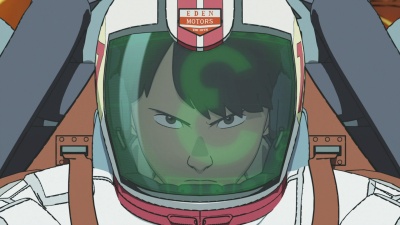 |
| [click on the thumbnail to enlarge] |
Following a series of catastrophic wars that left the planet a smoldering, uninhabitable cinder, the survivors of Earth carved out of a new society in a series of colossal domes on the moon. On the surface, Eden may appear to be as idyllic as its name suggests, but this futuristic metropolis is governed by the heavy hand of the Citizens Administration Council. This oppressively totalitarian group refers to its people by a series of cold, detached letters and numbers, shoves them into lifelong careers that may or may not be of the least bit of interest to them, and covertly restricts their movements and the flow of information.
The council first clashes with a fifteen year old named Takeru as he distracts himself from his impending regimentation into the status quo by racing a Lunar Terrain Vehicle. Takeru's LTV has been dramatically souped-up with the help of his friends Bis and Kazuma, and after his illegally raced lunar rover bursts into flames and causes him to miss curfew, his punishment is to skulk around outside the dome and verify the integrity of the arteries of pipes and cables leading into Eden. While unsupervised outside the dome, a hopelessly frustrated Takeru spots something careening to the lunar surface and bounds over to take a look. Inside the crater, he stumbles upon a photo of a beautiful teenage girl standing in front of a lush field of grass and some sort of launchpad, and a message reading "We are safe. Is anybody out there?" is scrawled on the back.
Instantly smitten,
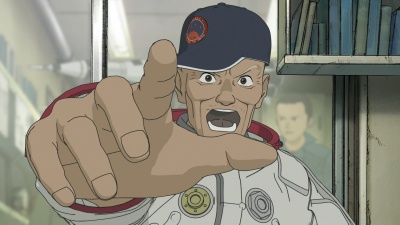 |
| [click on the thumbnail to enlarge] |
The first arc of Freedom is geared around a dark Orwellian future, and that dystopian sense of uneasiness and distrust is infused with energy through a series of hyperkinetic underground races and chases from armies of monstrous cybernetic spiders. The series takes a jarring shift in setting and tone as it settles into its fourth volume, though. Takeru and Bis spend half the episode piling onto a psychedelic VW bus with a man-ape, a Jimi Hendrix knock-off, and some schlub in a beer hat, with their road trip followed on a kitschy map with the names of cities and Route 66 logos bouncing around to some country-fried electric guitar lick. There's much more of an oddball sense of humor this time around, including an kinda-sorta-not-really-intergalactic dance party and a bit with Takeru practicing his romantic chops by having Bis squeak away in the role of a nameless girl in a photograph. It's literally a world removed from where the series began.
I'll admit to really disliking this stretch of the series when I first watched Freedom on HD DVD, and I think it's really just because it's essentially an entire different show. I'm sure that's the point, even: to contrast the distrust and cold technological bent of the lunar colony of Eden to a society that's archaic but practically utopian by comparison. It just seems awfully anticlimactic to open a series with swarms of teenaged racers
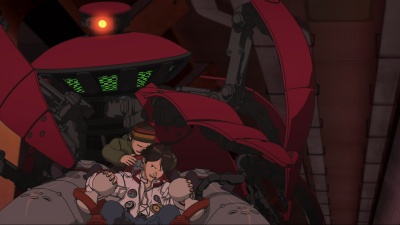 |
| [click on the thumbnail to enlarge] |
Even for those disappointed by the direction the series' second arc takes, Freedom is back at full strength by the time volume six rolls around, nimbly weaving together the present, faded memories of the past, and a future still to come. The characters' personalities are drawn more sharply, Freedom's themes and underlying message come much more into focus, and it starts to toy again with the concept of what freedom represents and the layers of mystery swirling around this dystopian future. I didn't have a chance to watch the series' double-length finale until this boxed set arrived, and I was thrilled to see Freedom come to such an outstandingly strong conclusion. The seventh and final volume brings these two very different arcs together, all of the lingering questions are at long last answered, and there's a sense of scope and enormity that eclipses anything Freedom has offered up to this point.
I definitely enjoyed Freedom. Its earlier volumes held up really well even the third and fourth times through, and I found myself having a much greater appreciation for its second arc when I rediscovered the series on Blu-ray. It doesn't quite ring true that the story hinges on a fifteen year old going to these mindbogglingly absurd lengths purely because he has a crush on a girl in a picture -- something that's smirked at late in the series -- but Freedom is anchored around an effective blend of shadowy intrigue, hyperkinetic action, and breezy fun. Freedom won't redefine the way you look at anime or anything, no -- although it may leave you aching for some Nissin Cup Noodles that get an awkward closeup or two every volume -- but this OVA is worth seeking out on Blu-ray. Recommended.
Video: Bandai Visual has given Freedom a new set of AVC encodes for this Blu-ray release, and the series looks incredible. The linework in the cel-shaded CG animation is exceptionally sharp and crisp, worlds removed from the limited resolution of a standard definition DVD. The 1.78:1 image is frequently bright and colorful -- it opens in a metropolis named Eden, after all -- and the occasionally painted backdrops add a layer of texture and personality that meshes
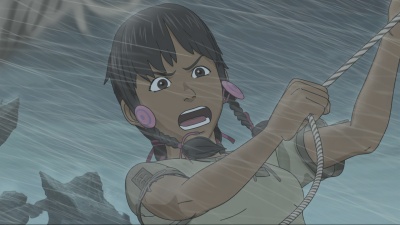 |
| [click on the thumbnail to enlarge] |
I'm really not left with much to complain about at all. There is some light aliasing along with a bit of banding, although both struck me as less distracting on Blu-ray than in the DVDs and HD DVDs I've watched of Freedom. I spotted one nasty instance of shimmering during a vertical pan early on, but nothing like that ever reared its head again. Even nearly a year and a half after I first caught Freedom on HD DVD, I'm still impressed by how wonderful the series looks in high definition, and it's appreciated that Bandai Visual went to the extra effort of re-encoding these seven volumes with Blu-ray expressly in mind.
Audio: Each volume of Freedom features its original Japanese audio in 24-bit Dolby TrueHD, and these lossless soundtracks are outstanding. There's a noticeable distinctness and clarity to every element in the mix, and the voice acting is especially clean and clear, never overwhelmed even in Freedom's most chaotic moments. The low-end is colossal: the roar of the souped-up LTVs, booming rocket thrusters, a violent hurricane, a few titanic explosions, and a remarkably punchy soundtrack. The series is littered with silky smooth pans from one channel to the next as the LTVs scream across the screen and swarms of spiderlike robots skitter in chase, swiping with enormous metal claws. Freedom takes full advantage of the six channels it has at its fingertips, and it's very welcome and completely unexpected for the series to be presented at such a high bit-depth, trumping much of what considerably larger studios have been releasing day-in and day-out.
Freedom also includes English and French dubs in Dolby TrueHD, although these lossless soundtracks are 16-bit, lagging behind the 24-bit Japanese audio. Subtitles are optionally offered in English and French as well. Each disc opens with a language selection screen -- Japanese, English, or French -- which defines the text for the submenus along with the default soundtrack. Pausing the episode and fiddling through a few submenus is a bit of a headache for those of us who don't speak Japanese but still want to watch Freedom in its original language.
Extras: There is one
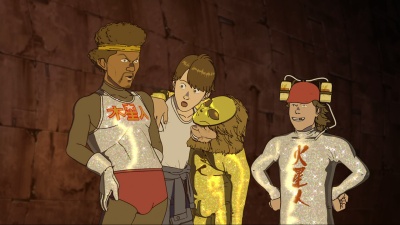 |
| ...the hell? |
"Talking About Freedom" is divided into two sessions with director Shuhei Morita and writers Dai Sato and Gichi Ohtsuka, focusing primarily on the first four installments of the series. Unfortunately, there's not really a followup delving into the other three volumes. The first session (17 min.) discusses the intermingling of an OVA with what amounts to a feature-length commercial and discusses the significance of what the Apollo program represents. For the most part, though, the emphasis is squarely on the writing process: how the series came together, the collaborative approach behind the assembly of the first arc, the integral roles that Katsuhiko Chiba (Outlaw Star; Gundam Wing) and Yuuichi Nomura (Gundam Seed) played, and the personalities and growth of Freedom's central characters.
The other session (21 min.) reflects on the first arc, touching on the expressiveness of these CG characters, the momentum that snowballed as the project went along, and Freedom's tendency to emphasize visuals and sound effects over dialogue. The three of them devote a fair amount of time to discussing the fourth episode of the series, including concerns about taking Freedom in such a dramatically different direction and laughing about their favorite scenes.
Sato and Morita are featured again in "Freedom in the USA". The first installment (11 min.) follows the two of them as they promote their OVA at Anime Expo '07 and as they briefly visit Route 66, a highway that plays a fairly prominent role in one volume of the series. In the second half (13 min.), Sato and Morita explore the National Air and Space Museum, researching the backdrop for one of Freedom's later volumes. Their awe and enthusiasm is infectious, marveling at sketched schematics, space suits, rockets, and lunar modules, and they're constantly relating these exhibits to Freedom's characters and storylines.
The Apollo program is also the focus of two other featurettes. "Fly Me to the Moon: The Apollo's Journey" (10 min.) uses an enormous amount of vintage footage and narration to cover the evolution of technology that led to the space race between the United States and the Soviet Union, paying particular attention to Robert Goddard, the father of modern rocketry who as far back as the 1920s believed it was possible to propel a rocket to the surface of the moon. This featurette is followed by "From the Apollo to Freedom" (14 min.), which explores the triumphs and tragedies of the Apollo program, early experiments with unmanned probes, as well as the Gemini tests that laid the groundwork for men to walk on the moon.
"Fly Me to the Moon",
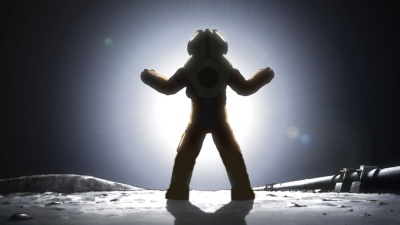 |
| [click on the thumbnail to enlarge] |
Several short snippets of additional footage have also been included, among them a handful of characters from Freedom who thank viewers for watching the series (2 min; 1080p). "Freedom: The Hope" is a minute and a half breakneck tunnel race set after the final volume, and a second race is featured in a 74 second proof-of-concept introduction with a very different visual style. Both of these short clips are presented in 1080i. The 90 second 'digests' that recap each volume of Freedom, presented in 1080p, are on this Blu-ray set as well, along with a windowboxed compilation of all of the Nissin Cup Noodle TV spots. A nine and a half minute reel of 'next episode' trailers rounds out the extras.
Each of the four discs in this boxed set comes packaged in what's otherwise a traditional Blu-ray case, only these are a very striking opaque black. These discs slip into a sturdy plastic shell over a cardboard sleeve, and the box includes a booklet on heavy stock excerpting 20 pages of the manga "Freedom: Just Short of Heaven's Gate".
Conclusion: Bandai Visual has done a commendable job bringing Freedom to Blu-ray, improving on the HD DVD volumes that slowly trickled out in virtually every way possible. This four-disc set boasts completely new video encodes, a slew of lossless soundtracks, a more extensive selection of extras, and a sticker price that's a fraction of what the HD DVDs were going for. Freedom can be kind of uneven, and I'll admit to really disliking its second arc the first time through, but I thought a lot more of the series when I had a chance to watch it in its entirety in one sitting. Its mix of hyperkinetic action in a dystopian future while still being light, breezy fun works really well, and although Freedom's asking price is high enough to still be kind of daunting, this OVA is worth discovering on Blu-ray. Recommended.
|
| Popular Reviews |
| Sponsored Links |
|
|
| Sponsored Links |
|
|
| Release List | Reviews | Shop | Newsletter | Forum | DVD Giveaways | Blu-Ray | Advertise |
|
Copyright 2024 DVDTalk.com All Rights Reserved. Legal Info, Privacy Policy, Terms of Use,
Manage Preferences,
Your Privacy Choices | |||||||













